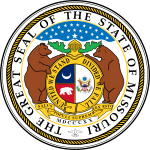| |||||||||||||||||
| |||||||||||||||||
 County results Stephens: 40–50% 50–60% 60–70% 70–80% 80–90% Lewis: 40–50% 50-60% 60-70% 70-80% | |||||||||||||||||
| |||||||||||||||||
| Elections in Missouri |
|---|
 |
The 1896 Missouri gubernatorial election was held on November 3, 1896, and resulted in a victory for the Democratic nominee, State Treasurer of Missouri Lawrence Vest Stephens, over the Republican candidate Robert E. Lewis, Prohibition candidate Herman Preston Faris, National Democratic candidate J. McDowell Trimble and Socialist Labor candidate Louis C. Fry.

